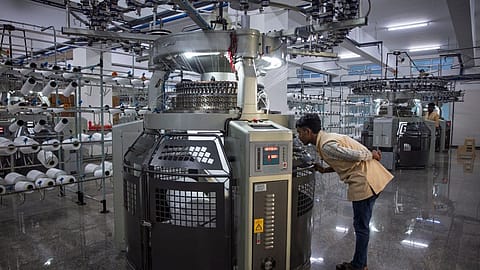Gokaldas Exports, Trident, Vardhman Textiles jump up to 8% after Trump’s 35% tariff on Bangladesh
US President Donald Trump shot off a tariff letter to Bangladesh, informing the country of a 35% reciprocal tariff rate from August 1, 2025.

Shares of textiles exporters traded in the green on Tuesday morning after US President Donald Trump shot off a tariff letter to Bangladesh, informing the country of a 35% reciprocal tariff rate from August 1, 2025.
Reacting to the news, Indian textile stocks witnessed a positive momentum. Shares of Gokaldas Exports soared 8.3% in opening trade to hit a high of ₹975 on the National Stock Exchange (NSE). Shares of Vardhman Textiles jumped 7.8% to ₹538 on the NSE. Ludhiana-based textile exporter Trident saw its stock price increase by 4.76% to ₹32.60 on the NSE.
This comes hours after Trump sent tariff letters to 14 countries: Bangladesh, Cambodia, Indonesia, Myanmar, Malaysia, Thailand, Japan, Korea, South Africa, Kazakhstan, Laos, Tunisia, Serbia and Bosnia and Herzegovina.
While China is the largest exporter of textiles and apparel to the United States, countries like Bangladesh, Vietnam, and India also export significant quantities to the US.
In his letter addressed to Muhammad Yunus, chief adviser of Bangladesh, Trump wrote that the trade relationship between the US and Bangladesh has been, “unfortunately, far from reciprocal.”
“We have had years to discuss our Trading Relationship with Bangladesh, and have concluded that we must move away from these long-term, and very persistent, Trade Deficits engendered by Bangladesh’s Tariff, and Non Tariff, Policies and Trade Barriers,” the letter read.
“Starting on August 1, 2025, we will charge Bangladesh a Tariff of only 35% on any and all Bangladeshi products sent into the United States, separate from all Sectoral Tariffs. Goods transshipped to evade a higher Tariff will be subject to that higher Tariff. Please understand that the 35% number is far less than what is needed to eliminate the Trade Deficit disparity we have with your Country. As you are aware, there will be no Tariff if Bangladesh, or companies within your Country, decide to build or manufacture product within the United States and, in fact, we will do everything possible to get approvals quickly, professionally, and routinely — In other words, in a matter of weeks,” Trump wrote.
Recommended Stories
“If for any reason you decide to raise your Tariffs, then, whatever the number you choose to raise them by, will be added onto the 35% that we charge. Please understand that these Tariffs are necessary to correct the many years of Bangladesh’s Tariff, and Non Tariff, Policies and Trade Barriers, causing these unsustainable Trade Deficits against the United States. This Deficit is a major threat to our Economy and, indeed, our National Security!” he said.
On Monday, Trump signed an Executive Order determining that certain tariff rates, which were initially set to expire on July 9, will expire on August 1, 2025.
“President Trump took these actions based on information and recommendations from senior officials, including information on the status of trade negotiations. Since President Trump modified the tariff rates roughly 90 days ago, dozens of countries have agreed or offered to lower their tariff rates and eliminate non-tariff barriers to move toward a more balanced trade relationship with the United States,” a release issued by the White House said.
“Notwithstanding this significant and historic progress, the U.S. trade deficit remains severe. While the United States is open to additional trade discussions and deals, President Trump is taking action to establish trade relations going forward,” it said.
(INR CR)


